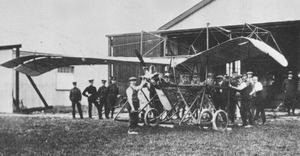First flight June 1911 Designer John William Dunne | Manufacturer Short Brothers | |
 | ||
The Dunne D.6 was one of J. W. Dunne's swept wing tailless aircraft designed to have automatic stability, flying about 1911. It was a single seat, single engined pusher monoplane and was developed into the Dunne D.7.
Contents
Design and development
Although J. W. Dunne is best known for his inherently stable tailless biplanes like the D.5 and D.8, he also developed a series of inherently stable monoplanes. He had submitted a monoplane design to the War Office in 1905 before he joined the Balloon/Aircraft Factory at Farnborough, though they rejected it. In 1907, employed by the Balloon Factory and encouraged by its head Colonel John Capper, Dunne is said to have built a parasol winged monoplane glider known as the Dunne-Capper glider.
All Dunne's tailless aircraft had swept wings with marked washout (reduction of angle of incidence) at the tips. Since sweepback placed the tips well behind the centre of gravity, they provided longitudinal (pitch) stability in just the same way as a conventional tailplane, mounted at lower incidence than the wing. Both the D.5 and the monoplanes had wing camber which increased outwards, though the wing profiles varied differently. The biplanes gained yaw stability from the inherent design of the wing, which the monoplanes augmented using down-turned wingtips. The glider mounted this wing above a pair of transverse A-frames, linked by longitudinal members that supported the pilot's arms; he controlled the aircraft by moving his weight.
Several of Dunne's aircraft from his Balloon Factory period were tested at Blair Atholl in Scotland to maintain secrecy, and some historians suspect that the Dunne-Capper glider was one of these, although Walker's thoroughly-researched account makes no mention of it., Piloted by Capper, these tests were not successful. Walker attributes these tests to the D.1 biplane glider.
The proposed glider is said to have been built with the intention of adding an engine, but this was not done until early in 1911, when a 60 hp (45 kW) Green was added in a pusher configuration. Three supporting A-frames were now present and the wing had wingtip elevons for control, though because of the down-turned tips these also provided some rudder-like forces. This version of the Dunne-Capper monoplane was tested at Larkhill on Salisbury Plain in January 1911 but failed to take off. The earlier undercarriage with two wheels on the rear A-frame and skids at the front was replaced by one with two pairs of wheels at the back and two more wheels at the front.
The D.6, major parts of which were built by Short Brothers, used a similar wing with a very different structure supporting it, the engine, pilot and undercarriage. The wing was straight edged, tapering from a central chord of 6 ft 3 in (1.91 m) to 5 ft 0 in (1.52 m) at the tips. The leading edge was swept at 35°. The A-frames with kingposts on the centreline were replaced with a pair of rectangular frames which extended above and below the wings, linked at the bottom by two transverse members. These frames served as double kingposts from which each wing was wire braced above and below. A substantial undercarriage structure was mounted at the bottom of the frames, comprising a long pair of skids which extended from the pusher propeller line well forward beyond the nacelle and curving strongly upwards. Each skid was multiply braced to its frame and inwards to the nacelle; the pair were joined by a cross strut near the forward tip. Both carried a pair of wheels and, at the rear, an articulated and sprung extension to absorb landing shocks.
The nacelle that carried the pilot's seat and the engine behind him was no more than an open wooden framework. The same Green engine was used as before, driving a two bladed, 7 ft 3 in (2.21 m) diameter propeller. A tall, rectangular radiator was placed longitudinally above the wing, positioned to raise the centre of gravity as high as possible. A pair of levers, one for each hand, controlled the aircraft.
This aircraft was tested at Eastchurch airfield on the Isle of Sheppey in June 1911, flown by Dunne. Designated the Dunne D.7 or D.7 Auto Safety. This was very similar to the D.6, but had a 1 ft (305 mm) shorter span and a 50 hp (37 kW) 7-cylinder Gnome rotary engine. It first appeared, not quite ready for flight, at the Olympia Aero Show in March 1911 and was on test with the D.6 at Eastchurch that June. Dunne was pleased with the improved performance. In January 1912 Dunne demonstrated the D.7 to members of the Royal Aeronautical Society, writing a note whilst flying hands off at 60 mph.
During 1912 the D.6 was modified into a two seater, the Dunne D.7 bis, with a 70 hp (52 kW) Gnome to cope with the increased load. It had the shorter span wing of the D.7, but a centrally mounted surface was added to improve pitch control. This aircraft was successfully flown at Villacoublay in France by either Dunne or N. S. Percival in April 1913.
Specifications (D.6)
Data from Goodall & Tagg 2001, p. 103
General characteristics
